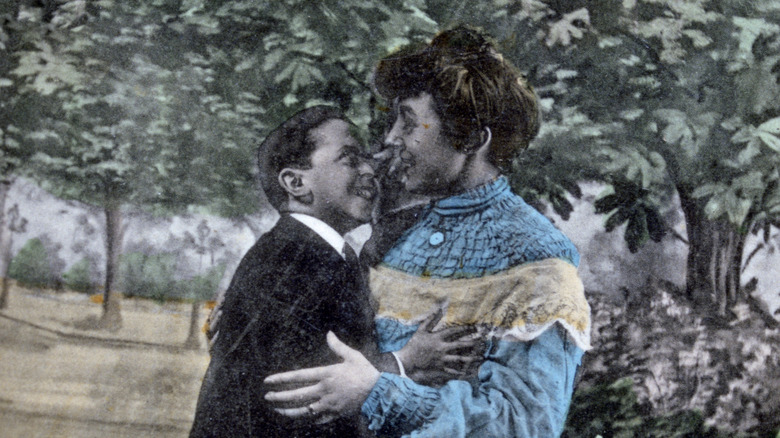Ed Gein's Repulsively Grotesque Motive For Murder
On the evening of November 16, 1957, authorities descended on the Plainfield, Wisconsin, home of 51-year-old Ed Gein. As reported by the Radford University Department of Psychology, Gein was the primary suspect in the disappearance, and possible murder, of 58-year-old Bernice Worden. While searching the scene of Worden's abduction, which was a general store, authorities found a receipt made out to Gein. According to the timestamp on the receipt, he was the last customer inside the store prior to closing.
When authorities entered Gein's home, they were horrified to discover Worden's mutilated corpse hanging upside down and headless from an exposed beam. A more thorough search of the home revealed a collection of human bones, body parts, and internal organs, which were displayed in nearly every room in the house. Radford University reports many of the remains had been preserved and fashioned into decor, furniture, and masks. Authorities also found a nearly complete bodysuit, which was made from the skins of multiple women.
Although he initially denied killing Worden, Gein eventually confessed. He also confessed to killing local bar owner Mary Hogan, who vanished in 1951. Gein is further suspected of having killed his brother Henry, 8-year-old Georgia Weckler, and 15-year-old Evelyn Hartley. However, authorities determined a majority of the remains found inside Gein's home came from corpses that he stole from graveyards.
As his mental health was in question, Radford University reports Gein did not stand trial for the murders until November 7, 1968. He was ultimately found not guilty due to insanity.
Ed Gein had a strange relationship with his mother
Although he was found not guilty due to his mental state, Gein was ordered to remain in a mental health facility indefinitely. The bizarre and disturbing condition of Gein's home brought national attention to the case and led everyone to question what could have driven someone to commit such heinous crimes. As reported by New Zealand Herald, it has been suggested that Gein's grief over the loss of his mother may have been the catalyst for his brutal crime spree.
By all accounts, Augusta Gein was a devoutly religious woman with a strong, and often controlling, personality. In an attempt to spare her sons, Ed and Henry, from situations and people she perceived to be evil, Augusta discouraged them from forming friendships outside the family. According to New Zealand Herald, she specifically warned them against drinking alcohol and spending time with women, using Bible passages to support her strict rules.
At school, Gein was often bullied about his speech impediment, which was caused by a growth on his tongue, and the appearance of his eye, which was also caused by an unusual growth. Radford University reports he was also known to be painfully shy. Gein ultimately dropped out of school after completing the eighth grade. In addition to helping with chores around the house, Gein began working as a handyman for others in the community. Following the death of Gein's father, in April 1940, Augusta's control over her sons only intensified.
Ed Gein was deeply affected by his mother's death
Ed seemed to go along with all of his mother's rules with little, if any, question. However, Henry began to openly criticize his mother and even questioned Ed's willingness to appease her. As reported by Radford University, Henry died under unusual circumstances on May 16, 1944. According to official reports, Ed told authorities he and his brother were attempting to extinguish a blaze near their home when he and Henry became separated.
Henry was later found dead near the perimeter of the fire, and Ed told authorities he was likely injured, and eventually died, in the fire. However, there was no evidence that he had been burned. Although Henry's cause of death was later determined to be asphyxiation and the manner of death was determined to be accidental, it has been suggested that Ed was directly responsible for Henry's death.
Gein's mother, Augusta, died on December 29, 1945 at the age of 67. Immediately following her death, Gein boarded up his mother's bedroom and sitting room without disturbing any of the content. The rooms remained preserved, like a museum, until police searched the home nearly 12 years later.
Gein spent a lot of time at the cemetery visiting his mother's grave. However, at some point, he decided to dig up her corpse and take it home with him. According to Radford University, he then proceeded to dismember and preserve her corpse.
Doctors determined Ed Gein had an abnormal attachment to his mother
According to Radford University, Ed Gein removed his mother's head from the rest of her corpse and preserved it as outlined in a book he read about "shrunken heads." He then removed her skin, which he used to begin making a human skin suit.
Isthmus reports Dr. Schubert, who interviewed Gein, said the accused killer had formed an "abnormally magnified attachment to his mother." Dr. Warmington, who also interviewed Gein, said Gein's obsession with his mother was paired with an underlying anger and a degree of sexual repression.
Following his mother's death, Warmington believes Gein developed a strong "desire for a substitute for his mother in the form of a replica or body that could be kept indefinitely." It has been noted that most of Gein's victims, including the corpses he stole, had some resemblance to his mother.
As reported by TruTV, Gein had considered gender reassignment surgery at one point, as he wanted to become more like his mother. However, he ultimately decided to use her actual body to satisfy his obsession. Gein used his mother's skin to make an outfit, which he wore at home, and at times while he was robbing other graves.
According to some reports, the original suit Gein made of his mother's skin began degrading, prompting him to make a new suit using more recently buried corpses. Gein would often scan obituaries and steal corpses on the same evening they were buried.



